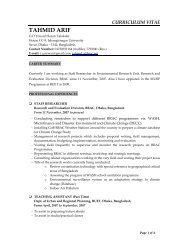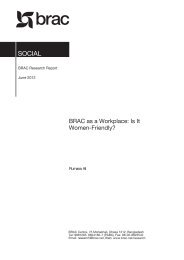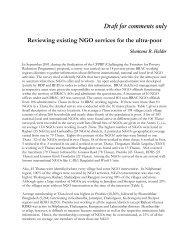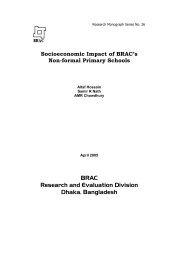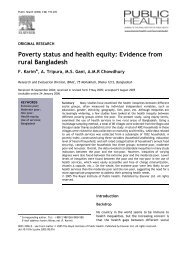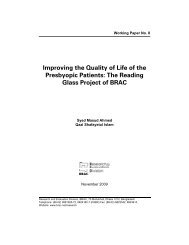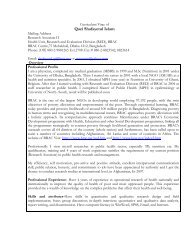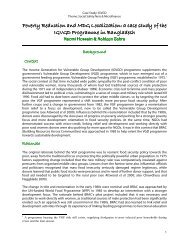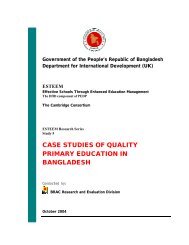Combining health and social protection measures to reach the ultra ...
Combining health and social protection measures to reach the ultra ...
Combining health and social protection measures to reach the ultra ...
Create successful ePaper yourself
Turn your PDF publications into a flip-book with our unique Google optimized e-Paper software.
Research resources<br />
18<br />
16<br />
14<br />
No. of PPPs<br />
12<br />
10<br />
8<br />
6<br />
4<br />
2<br />
0<br />
1986 1987 1988 1989 1990 1991 1992 1993 1994 1995 1996 1997 1998 1999 2000 2001 2002 2003<br />
<strong>the</strong> developing world, such as malaria <strong>and</strong> tuberculosis;<br />
✜ are seriously disabling or life threatening, for which<br />
treatment options are inadequate or do not exist such as<br />
leishmaniasis <strong>and</strong> Chagas’ disease;<br />
✜ could be cured or prevented with <strong>the</strong> currently available<br />
science <strong>and</strong> technology, but for which research <strong>and</strong><br />
development has ground <strong>to</strong> a st<strong>and</strong>still;<br />
✜ do not constitute a valuable enough market <strong>to</strong> stimulate<br />
adequate research <strong>and</strong> development of new medicines;<br />
✜ governments have failed <strong>to</strong> redress market failure.<br />
To redress <strong>the</strong> imbalance in availability of medicines <strong>to</strong><br />
developing countries, PPPs are used as a means <strong>to</strong> ga<strong>the</strong>r<br />
resources <strong>and</strong> funding <strong>to</strong> be applied <strong>to</strong> solving this problem,<br />
as by <strong>the</strong> 1990s, both <strong>the</strong> private <strong>and</strong> public sec<strong>to</strong>rs<br />
acknowledged that “a pure market mechanism generally does<br />
not work” 12 where medicines are involved <strong>and</strong> new<br />
approaches needed <strong>to</strong> be developed.<br />
Millions of people globally die or become disabled from<br />
diseases for which <strong>the</strong>re are inadequate or no medicines <strong>and</strong><br />
<strong>the</strong> free market had no incentive <strong>to</strong> develop such medicines.<br />
From 1975 <strong>to</strong> 2004 only 1.3% of <strong>the</strong> 1556 new chemical<br />
entities marketed were registered for tropical diseases <strong>and</strong><br />
tuberculosis despite <strong>the</strong> fact that <strong>the</strong>se diseases account for<br />
12% of <strong>the</strong> global disease burden 17 . Partnerships <strong>and</strong> more<br />
specifically, PPPs were created <strong>to</strong> fill this void.<br />
Barriers <strong>to</strong> access <strong>to</strong> products <strong>and</strong><br />
treatments for diseases of <strong>the</strong> poor<br />
The barriers <strong>to</strong> access <strong>to</strong> products <strong>and</strong> treatment for diseases<br />
of <strong>the</strong> poor that <strong>the</strong>se partnerships have been created <strong>to</strong><br />
address can be classified under <strong>the</strong> following six groupings.<br />
1. Lack of affordable, effective safe diagnostics, medicines, or<br />
vaccines.<br />
2. The cost of <strong>the</strong> products, medicines, <strong>and</strong> vaccines (<strong>to</strong> both<br />
<strong>the</strong> National Health Service <strong>and</strong> <strong>to</strong> individuals).<br />
Year<br />
Figure 1: Number of Public-Private Partnerships created between 1986 <strong>and</strong> 2003<br />
Source: Extracted from data found on <strong>the</strong> website for Initiative on Public-Private<br />
Partnerships for Health, www.ippph.org. Accessed week of February 1-8, 2006<br />
3. Lack of a reliable supply of products, medicines, or<br />
vaccines.<br />
4. Weak/fractured <strong>health</strong> systems.<br />
5. Cultural perceptions <strong>and</strong> beliefs.<br />
6. Political will.<br />
The majority of PPPs were formed in <strong>the</strong> past seven years<br />
as illustrated in Figure 1, corresponding <strong>to</strong> interest <strong>and</strong> energy<br />
from private foundations, particularly <strong>the</strong> Rockefeller<br />
Foundation <strong>and</strong> <strong>the</strong> Bill & Melinda Gates Foundation.<br />
Kinds of partnerships<br />
In general, public-private partnerships can be broadly<br />
categorized in<strong>to</strong> <strong>the</strong> following areas: (1) product distribution<br />
or disease control programmes; (2) product development;<br />
<strong>and</strong> (3) policy, advocacy, or <strong>health</strong> systems issues 18 .<br />
1. Disease control programmes/product distribution.<br />
Certain PPPs are designed <strong>to</strong> improve access <strong>to</strong><br />
treatment in developing countries by improving<br />
distribution of medicines or medical products <strong>to</strong> prevent<br />
or treat specific diseases. The disease control<br />
programmes are mainly through drug donations; <strong>the</strong>re<br />
are now four major drug donations for annual mass<br />
treatment: Ivermectin, MSD, for onchocerciasis (Merck &<br />
Co. Inc.); azythromicin for Trachoma (Pfizer);<br />
Albendazole <strong>and</strong> Ivermectin for lymphatic filariasis (Glaxo<br />
Smith-Kline, Merck & Co. Inc.), mebendazole for soil<br />
transmitted helmin<strong>the</strong>s in children (Johnson <strong>and</strong><br />
Johnson) <strong>and</strong> two for individual treatment; leprosy<br />
(Novartis) <strong>and</strong> sleeping sickness (Aventis, Bris<strong>to</strong>l-Myers<br />
Squibb).<br />
2. Product development. The majority of partnerships focus<br />
on <strong>the</strong> development of medicines, vaccines, or products for<br />
use in <strong>the</strong> treatment or prevention of neglected diseases 19<br />
such as <strong>the</strong> Medicines for Malaria Venture (MMV), The<br />
International AIDS Vaccine Initiative (IAVI) <strong>and</strong> <strong>the</strong> Global<br />
Alliance for Vaccines <strong>and</strong> Immunization (GAVI Alliance).<br />
Global Forum Update on Research for Health Volume 4 ✜ 133




